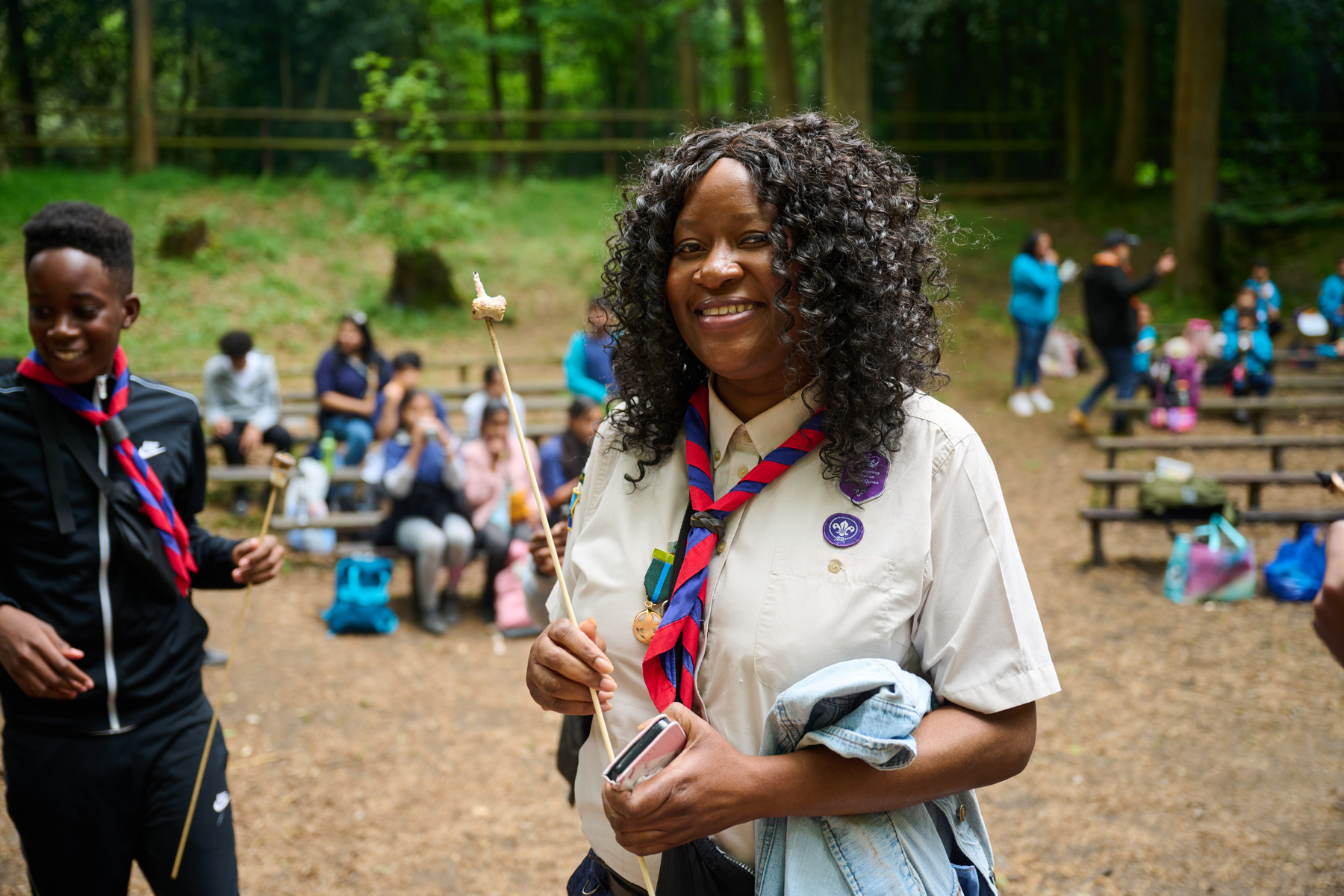Useful items to take as a trip leader for the whole group
Got the Night’s Away permit, got the enthusiasm, now let's talk kit.
Planning a Nights Away event, such as a camp, means having the right tools to keep everyone happy and comfortable.
Think first aid kits for those inevitable bumps and bruises, a trusty map to avoid getting lost (or pretending not to), and of course, a reliable communication plan.
We're here to break down the must-haves for your trip, so you can lead with confidence and tackle anything the great outdoors throws your way. So let's gear up for success!

- A fully stocked and up to date first aid kit, including for burns, and a first-aid record book
- A tick remover
- Bottled water for emergencies
- Any fire-fighting equipment, such as fire extinguishers, fire blankets, sand and metal buckets
- Access to a car or taxi service number and a spare car seat for emergencies
- Cash and coins for emergencies
- An emergency kit (depending on facilities) including whistle, emergency blankets, jump leads, ice scraper, shovel or spade, and wind up torch
- Laminated cards with contact details on to give to young people for emergencies
- Repair kits, such as for tent or bike puncture
- A way to store medicines and any money safely
You should take copies of the following in a secure folder:
- Multiple copies of each of the Safe Scouting cards, including the Yellow Card, given to each adult and/or young leader present
- A register of attendees and a pen
- All activity information forms
- All attendees medical information, including dietary requirements and allergies
- All attendees relevant emergency contacts
- Your InTouch contact’s contact details
- Your Nights Away Notification forms
- All attendees' photography permissions
- Details of on-site contacts, local emergency services and nearest hospital
- Any reasonable adjustments and parent/carer questionnaires
- Any permits and licences, such as Nights Away Permit, Minibus Permit and Adventurous Activity Permits
- Menus and information regarding allergies, dietary requirements, eating problems and fasting
- Your risk assessments and the risk assessments of the site, activities or facilities
- Activity plans and schedules
- Site maps
You may also want to give copies of any relevant documents to volunteers and adults on site, as appropriate.
For example, people may need a copy of activity plans and schedules. Remember to follow GDPR guidelines at all times.
- A Scout phone to store numbers in
- Any Scout badges or certificates you’ll need
- A spare Scout necker
- Any flags
- Your Scout teddy or mascot
- Any tents, sleeping bags or other equipment the Scout group is supplying
- Spare mallet, tent pegs and poles
- Windbreaks for privacy
- A strong and sturdy water carrier, as well as a backup
- Hanging lanterns for inside tents
- A camping trolley
- Duct tape and scissors
- Cable ties
- Gazebos, shelters or tent porches
- Camping or chemical toilets, if needed on greenfield campsites
- Cleaning gloves, products and equipment that are designed for domestic use and somewhere to lock them away, safely out of reach.
- A way to extinguish fire, such as a fire extinguisher and metal bucket for sand or water
- Tinder, kindling and firewood
- An axe and saw for chopping firewood that’s suited to the job and your level of ability. Remember to always fit masks or sheaths to axe heads and saw blades, which should fit securely. Keep axes and saws dry, and never leave them out overnight. Keep them in a stores tent in a locked box, out of reach of young people. Penknives and camping knives should also be stored in this box when out of use. Take a look at our knife safety guidance.
- Suitable chopping block
- Hardware gloves for chopping and sawing firewood
- Heatproof gloves
- Heatproof log tongs
- Heatproof toasting forks
- A log store
- Matches
- Firelighters
- Spade
- Toasting forks
- Any separate equipment you need for dietary requirements
- Pens
- Debit or credit cards
- Any activity items, including safety and personal protective equipment
- A shared leader rucksack or day-bag
- Spare bags for life
- A camera and charger
- A map and compass
- A squeeze whistle for games or emergency stop
- Ways to be seen, such as high visibility jackets and high visibility rucksack covers
- Lockable storage to store medication and purses/wallets in
- Spare tarpaulin - great for storing luggage on a wet field
- Sun cream
- Spare hats and sunglasses, as well as spare gloves, blankets, scarfs and hats
- Toilet rolls, including something waterproof to store it in if outdoors
- Period products, including pads and tampons, and a way to store them (such as a bag or box in bathrooms)
- Biodegradable wet wipes
- Insect repellent
- Spare toiletries, such as shampoo, conditioner, body wash, toothbrushes and toothpaste
- Shower caps, which are good to stop cold, wet hair at night and can also be useful for covering the bottom of muddy boots
- Food and drink required for camp
- Supplemental food and snacks for any dietary restrictions
- Any condiments, oils or spices
- Any cool-boxes and ice packs
- Utensils and equipment for cooking, such as stoves, tin openers, bottle openers, mixing bowls, barbecues, chopping boards, pans, lids and baking trays
- Personal protection equipment, such as aprons, heatproof gloves and oven gloves
- A heatproof surface or stable heatproof surface protectors, such as trivets
- Matches
- Hygiene equipment, such as gloves or hairnets
- Ways to store food items, such as air-tight tins or portable shelves
- Ways to store leftovers safely, such as air-tight containers and tinfoil
- A battery operated carbon monoxide alarm
- A way to extinguish fire, such as a fire blanket, fire extinguisher or metal bucket of sand
- Outdoor cooking equipment, such as toasting forks, campfire grill or a Dutch oven
- Portable, not disposable, barbecues and charcoal
- Any separate equipment or utensils you need for dietary requirements
- Picnic benches, if needed
- Camp chairs
- Tablecloth, placemats, napkins, mugs, cups, bowls, plates and cutlery
- Drink dispenser and a washing up bowl to catch any drips
- An urn or kettle for hot drinks
- Fruit bowl
- Ways to serve food and drinks, including utensils and hygiene equipment
- Any separate equipment you need for dietary requirements, such as separating serving utensils
- Laundry detergent
- Cleaning equipment, such as anti-bacterial sprays, or a dustpan and brush to wipe out tents
- Antibacterial hand soap
- Washing up bowl, washing up liquid, dishcloth, tea towels and scrubbing brush
- A hand washing station
- Kitchen roll
- Clothes line and pegs to dry clothes
- Hand sanitiser
- Antibacterial sprays and wipes
- A dustpan and brush
- A ‘doormat’ to wipe feet on to enter tents
- Storage tubs or laundry baskets to gather shoes, loose items, lost property, plate bags and so on at the door to prevent trips and keep things tidy
- A pop-up bin and bin bag (great for on a mini bus!)
- Bin bags, including extra for damp clothes
- A non-recyclable bin and recycling bins, but not in their tents
- Extension leads
- A fully-charged, portable battery pack
- Phone chargers
- Outdoor lights, such as solar powered fairy lights or lanterns
- Hair ties for long hair
- Spare clothing, such as top, trousers, socks, underwear, coat, gloves, hats or nightwear for age group
- Spare towels and toiletries, such as toothbrushes, suncream, period products, toothpaste and shampoo
- Some sticky labels and a permanent marker to help label items
- Spare head torches, lanterns, torches and spare batteries
- Spare shoelaces for walking boots
- Extra sleeping bag, blankets, roll mat and pillow for any accidents
- Spare waterproof coats and waterproof trousers
- Ear defenders
- Board games
- Cards
- Outdoor toys or balls
- Books
- Pens and paper
- Walkie talkies for adults
- Picnic blankets to sit on
- Umbrellas for rain or shade
- Fans for hot weather
- A large whiteboard and whiteboard pen to write schedules, groups or menus on
- Portable, pop up changing rooms, if needed
- Floor cushions/sitters
- Tent carpets
- Speaker

How to make my kit as eco-friendly as possible
Whether you’re holding a sleepover, having an indoor residential event or going camping in the fields, there are ways to help make your trip better for the environment. Here are our top tips to plan an eco-friendly camp that everyone will enjoy.
- Borrow items rather than buying new ones.
- If you need to buy kit, opt to go for safe, high-quality second hand items.
- Always clean and store equipment properly to prevent damage between trips.
- Offer broken equipment or kit to the local community for free. Someone may be able to use the spare parts to help mend their own equipment.
- Buy a selection of kit for your group or section, so it can be reused by future members.
- Write a kit list to determine exactly what your group needs for your adventure.
- Encourage people to bring biodegradable or sustainable plastic-free items, such as shampoo bars or bamboo toothbrushes.
- Have recycling bins available throughout the event
- Try to reduce paper and single use plastic, where possible, such as by using reusable plates, bowls and cutlery, You can also avoid paper napkins, plastic straws, water balloons, glow sticks and disposable barbecues.
Take a look at our blog on How to run a sustainable camp or sleepover for more guidance.